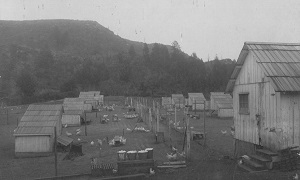Agriculture, Ask A Librarian
Napa County’s Agricultural History
Did people grow anything other than wine grapes in Napa County?
Yes! Napa has long been famous for its variety of agricultural products. The temperate, modified coastal climate makes the region less foggy than San Francisco, but cooler than the much hotter inland areas of the Sacramento and San Joaquin valleys. Its numerous valleys are surrounded by several volcanic mountain ridges, providing fertile soil perfect for raising livestock and growing grains, fruits, nuts, and, of course, grapes.
During Napa’s Rancho period (1836-1846) when the land was known as Alta California and was still part of Mexico, rancho owners grew wheat along the Napa River. Mostly they grazed cattle, sheep, and horses. After the Americanos brought California into the United States in 1850, its agricultural production increased. Large ranchos were broken into smaller farms, ranches, and vineyards. Napans planted just about everything. Farmers dabbled in hops production, growing raisins, and even planted mulberry trees in an attempt to produce silk. Rice fields were laid out around what is now Meadowood Resort in St. Helena. Anna Brannan, wife of Sam Brannan, founder of Calistoga, tried to grow tea plants.
We grew so much grain in Napa County that we were actually famous for it. In 1889, Napa County was the second largest wheat producer in the state. Teams of four to eighteen or more men would work using bulky, massive machinery to harvest, bale, thresh, winnow, and store the feed and grain crops before the harvest was sent to nearby mills to be ground into meal or flour and then shipped to grocery stores around the world. The Illustrations of Napa County California with Historical Sketch, published in 1878 by Smith & Elliot, exclaimed: “California agriculture is the wonder of the world. [In 1878] the foremost wheat and barley and wool and wine and fruit producing and exporting State in the Union…During the months of February and March…the whole country is a mass of green, the grain fields are covered with a rich, strong growth of wheat, oats, and barley.”
We were also very well known for our orchard produce. Many different kinds of fruits and nuts have been planted over the years. In 1899 there were nearly 300,000 fruit trees, and by 1909 there were more than 500,000 fruit and nut trees in the valley. Our most common crops were apples, cherries, apricots, peaches, pears, plums, tomatoes, olives, almonds, and walnuts. But mostly we grew prunes. French prunes were introduced in Napa in 1883, and for nearly half of the 20th century, prunes were our largest fruit crop, second only to grapes.
Stop by soon to see our current exhibit “Farming: From Planting to Picking.” This exhibit will only be up through the beginning of October.


